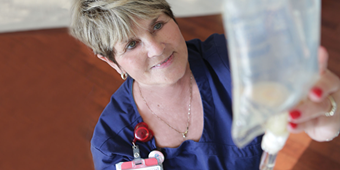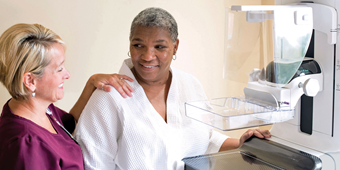Setting the Stage for Breast Cancer Treatment

Answer a few questions and we'll provide you with a list of primary care providers that best fit your needs.
How do your doctors decide how to treat your particular breast cancer? Staging the cancer is a critical step.
“Staging is the process of finding out how widespread the breast cancer is,” says Thomas Heck, MD, Surgical Director at the breast center at Miami Valley Hospital North. “The stage is the most important factor in deciding how to treat the cancer.”
To determine the cancer’s stage, doctors must answer these questions:
- Is the cancer invasive or non-invasive? Non-invasive cancers stay within the milk ducts or lobules in the breast. They don’t grow into normal tissues within or beyond the breast. Non-invasive cancers are sometimes called carcinoma in situ (“in the same place”) or pre-cancers.
- How big is the breast tumor?
- Has the cancer spread to nearby lymph nodes? If so, how many are involved?
- Has the cancer spread to other parts of the body?
Your doctor will use your physical exam, biopsy, and tests that may be recommended (such as a chest x-ray, mammograms of both breasts, bone scan, CT scan, MRI, PET scan, blood tests) to determine the stage of your cancer.
The earliest stage cancers are called stage 0 (carcinoma in situ), and then range from stages I (1) through IV (4). “As a rule, the lower the number, the less the cancer has spread,” says Dr. Heck. “A higher number, such as stage IV, means a more advanced cancer.
“The stage is the most important factor in deciding how to treat the cancer.”
Some of the stages are further divided into sub stages using the letters A, B, C. The earlier the letter, the better that particular stage is.
Survival Rates
The five-year survival rate is the percentage of women who live at least five years after being diagnosed with breast cancer. “Keep in mind, however, that many women live much longer than five years after diagnosis,” says Dr. Heck.
The five-year relative survival rates by breast cancer stage are:
- Nearly 100% for stage 0 and stage I breast cancer. The tumor is small and only in your breast. Or there is only a very small amount of cancer cells in your arm pit lymph nodes.
- 93% for stage II breast cancer. The tumor is small but cells have spread to your lymph nodes. Or the tumor is a little larger but there are no cells in the lymph nodes.
- 72% for stage III breast cancer. The tumor is any size and has spread to lymph nodes, the chest wall, and/or to the skin over the breast, but not to distant areas in the body.
- 22% for stage IV breast cancer. The cancer has spread to other organs.
Answer a few questions and we'll provide you with a list of primary care providers that best fit your needs.
Source: Thomas Heck, MD, Gem City Surgical Associates; American Cancer Society; Breast Cancer Grades





